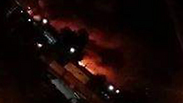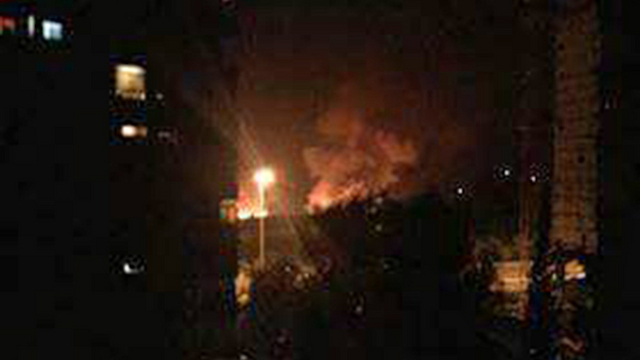
Is Syrian retaliation against Israel in the works?
Analysis: The latest alleged Israeli strike in Damascus was unusual due to the use of surface-to-surface missiles, likely in order to avoid friction with the Russians. Meanwhile, Assad is gaining confidence thanks to the Russian backing and may be preparing a clash with Israel in the near future.
The strike was likely the result of an Iranian attempt to transfer rockets or accurate surface-to-surface missiles to Hezbollah, as Defense Minister Avigdor Lieberman implied as well in his meeting with European Union ambassadors Wednesday. The report suggests that the targets were attacked in an air base to which the Iranians routinely send the high-quality arms shipments to be transferred to Hezbollah in Lebanon through Syria.
There is of course a possibility that Israel attacked something else other than arms shipments to Hezbollah, but that it highly unlikely. Israel is not intervening in the civil war in Syria, and if it does intervene—it's only in response to a violation of its sovereignty by Syria or by one of the organizations operating from Syrian territory. In this case, it was likely another attempt to transfer weapons to Hezbollah, like the one that was thwarted last week, according to foreign reports.
In the past, there were claims made that Israel occasionally uses guided surface-to-surface ”Tammuz” missiles when the Syrian army or the rebels in Syria fire shells on Israeli territory in the Golan Heights, whether intentionally or erroneously (which known as a "spillover"). These missiles have usually been fired at relatively short ranges.
But the military air base in Damascus is located at least 40 kilometers (25 miles) from the Israeli border, which means that Israel would have to use accurate rockets or missiles of a larger range to accurately hit targets there.
According to foreign reports, Israel has a wide variety of missiles produced by the Military Industries which are suitable for an extremely accurate hit at a target located dozens and even hundreds of kilometers from its territory.
Accurately dropping bombs is usually cheaper than firing surface missiles. The cost of one accurate rocket is higher than the cost of accurate aerial munition, even when taking into account the cost of operating the plane and the pilot.
It’s reasonable to assume, therefore, that if Israel did in fact use surface-to-surface missiles, as the Syrian media claimed, it had a good reason to do so. The reason was likely a desire to surprise the Syrians and Hezbollah in the area of the attacked target.
Had Israel launched planes to carry out the mission, they would not have had to enter Syrian territory to hit the air base and could have simply flown over the sea or over Lebanese territory. But the sensitive and long-range radars, which the Russians brought to Syria when they entered the fray, would have been able to detect the presence of Israel Air Force planes in the area. It’s even possible that the Russians would have warned the Syrian antiaircraft batteries which, according to reports, have already tried to hit Israeli planes as they embarked on missions to stop Hezbollah from arming itself.

So if Israel did use surface-to-surface missiles rather than aerial munition, it may have been done to prevent the Russians from being able to warn the Syrians of the Israeli strike.
Another possibility is that Israel is afraid that the Russians will try to intercept its planes with SA-300 and SA-400 missile batteries. This option is not as likely as the first option, but it should be taken into account.
In any event, if we rely on the reports from Syria, the desire to surprise Hezbollah and the Syrians even before the weapons start making their way to the Lebanon border, as well as the desire to avoid friction with the Russians, led to the use of surface-to-surface missiles which are as accurate and destructive as aerial munition.
While Israel is adapting to the conditions on Syrian territory, Syria is gaining confidence in the light of Russian involvement and the backing it receives from Moscow. Today, there is a higher chance than before that Syrian President Bashar Assad will clash with Israel and threaten its Air Force planes.
We should pay attention, therefore, not just to the claim that Israel used surface-to-surface missiles, but also to the fact that the official Syrian news agency and Syrian television provided details on the recent attacks and did not conceal them as the Syrian regime has done in the past.
Assad decided not to use the denial options provided by Israel when it avoided announcing the strike or confirming that it happened. In previous cases, the Syrians preferred to ignore the Israeli strikes, and only admitted that they happened when they had no other choice. This time, they initiated the announcement.
This may have been aimed at creating the justification and background story in the global public opinion for a Syrian-Hezbollah act of retaliation against Israel, which may already be in its planning and preparation stages. Israel should be prepared for the possibility of such an act being carried out in the near future, perhaps even with Russian assistance and backing.











